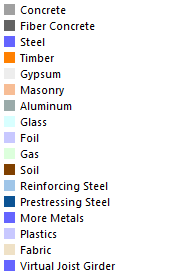Materials are required to define elements and parts.
The material number is assigned automatically, but can be changed. The order is irrelevant for the numbering. It does not have to be continuous, either; gaps in the numbering are allowed.
List
The "List" manages all materials of the model. The List of Object Types table describes the functions with which you can create, copy, or delete objects of a list.
Name
You can define any name for the material. If the description matches an entry in the library, RSECTION imports the stored material properties. To select a material from the library, click the
![]() button at the end of the input line. The import of materials is described in the chapter Material Library.
button at the end of the input line. The import of materials is described in the chapter Material Library.
For materials from the library, the "Basic Material Properties" are set by default and cannot be changed. If you want to use user-defined properties of the material, select the User-defined material check box in the "Options" section (see the section User-Defined Material).
Main
The Main tab manages the basic material parameters.
Material Type
The material type is used to define the category of the material. For a material taken from the library, one of the following material types is preset.
Modulus of Elasticity
The modulus of elasticity E describes the ratio between normal stress and strain. Like the shear modulus, it is included in the calculation of the fade factor 𝜆 and is required for determining ideal section properties of cross-sections made of different materials.
Shear Modulus
The shear modulus G, also known as the sliding modulus, is the second parameter for describing the elastic behavior of a linear, isotropic, and homogeneous material.
Poisson's Ratio
Poisson's ratio ν for isotropic materials is usually between 0.0 and 0.5. Therefore, for a value of 0.5 or higher (for example, rubber), it is assumed that the material is not isotropic.
The relation between the modulus of elasticity, shear modulus, and Poisson's ratio for an isotropic material is described in the equation Poisson's Ratio.
|
E |
Modulus of elasticity |
|
G |
Shear modulus |
|
ν |
Poisson's ratio |
If you manually define the properties of an isotropic material, RSECTION determines Poisson's ratio from the values of the modulus of elasticity and the shear modulus. If necessary, you can change this presetting in the "Definition type" list.
Definition Type for Material Properties
| E |
|
|
The Poisson's ratio is determined from the modulus of elasticity and the shear modulus. |
| E |
|
|
The shear modulus is determined from the modulus of elasticity and the Poisson's ratio. |
| E |
|
|
The modulus of elasticity, shear modulus, and Poisson's ratio are independent of each other. |
Specific Weight / Mass Density
The specific weight γ describes the weight of the material per volume unit. This value is required to determine the section weight.
The density ρ describes the mass of the material per volume unit.
Coefficient of Thermal Expansion
The coefficient of thermal expansion α describes the linear correlation between changes in temperature and length (elongation of material due to heating, shortening due to cooling).
User-Defined Material
The material properties for materials from the library are preset. Therefore, they cannot be changed directly in the text boxes.
To adjust the properties of a material, select the User-defined material check box in the "Options" dialog section. Then, the text boxes in the "Basic Material Properties" dialog section of the "Main" tab become accessible.
You can also change the parameters in the "Material Values" tab.
In the "Stiffness Modification" tab, you can also define division or multiplication factors for the modulus of elasticity and the shear modulus.



